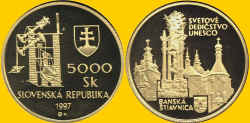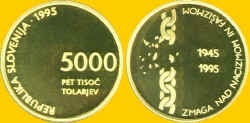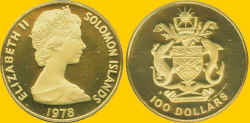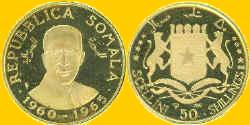This is the Worldwide Numismatics Website!
This is a modest collection of second millennium gold coins
Click the thumbnail picture to see a larger version of the picture, then use your browser BACK button to return to the original page you were viewing.
SLOVAK REPUBLIC
Slavic tribes occupied what is now Slovakia in the 5th century AD. In 833, the prince of Moravia captured Nitra and formed the Great Moravian Empire, which included all of present Central and West Slovakia, the Czech Republic and parts of neighbouring Poland, Hungary and Germany. The empire converted to Christianity with the arrival of the Thessaloniki brothers and missionaries, Cyril and Methodius, in 863. In 907, the Great Moravian Empire collapsed as a result of the political intrigues of its rulers and invasion by Hungary. By 1018 the whole of Slovakia was annexed by Hungary and remained so for the next 900 years, although the Spis region of East Slovakia belonged to Poland from 1412 to 1772. After a Tatar invasion in the 13th century, the Hungarian king invited Saxon Germans to settle the depopulated north-eastern borderlands. When the Turks overran Hungary in the early 16th century, the Hungarian capital moved from Buda to Bratislava. Only in 1686 was the Ottoman presence finally driven south of the Danube. The formation of the dual Austro-Hungarian monarchy in 1867 gave Hungary autonomy in domestic matters and a policy of enforced Magyarisation ('Hungarianisation') was instituted in Slovakia between 1868 and 1918. In 1907 Hungarian became the sole language of elementary education. As a reaction to this, Slovak intellectuals cultivated closer cultural ties with the Czechs, who were themselves dominated by the Austrians. The concept of a single Czecho-Slovakian unit was born for political purposes and, after the Austro-Hungarian defeat in WWI, Slovakia, Ruthenia, Bohemia and Moravia united as Czechoslovakia. The centralising tendencies of the sophisticated Czechs alienated many Slovaks and, after the 1938 Munich agreement that forced Czechoslovakia to cede territory to Germany, Slovakia declared its autonomy within a federal state. The day before Hitler's troops invaded Czech lands in March 1939, a clero-fascist state headed by Monsignor Jozef Tiso (executed in 1947 as a war criminal) was set up, and Slovakia became a German ally. In August 1944, Slovak partisans commenced the Slovak National Uprising which took the Germans several months to crush. In the wake of Soviet advances in early 1945, a Czechoslovak government was established at Kosice two months before the liberation of Prague. The second Czechoslovakia established after the war was to have been a federal state, but after the communist takeover in February 1948 the administration once again became centralised in Prague. Many of those who resisted the new communist dictatorship were ruthlessly eliminated by execution, torture and starvation in labour camps. Although the 1960 constitution granted Czechs and Slovaks equal rights, only the 1968 'Prague Spring' reforms introduced by Alexander Dubcek (a rehabilitated Slovak communist) implemented this concept. In August 1968, Soviet troops quashed democratic reform, and although the Czech and Slovak republics theoretically became equal partners, the real power remained in Prague. The fall of communism in Czechoslovakia during 1989 led to a resurgence of Slovak nationalism and agitation for Slovak autonomy. After the left-leaning nationalist Vladimir Meciar was elected in June 1992, the Slovak parliament voted to declare sovereignty and the federation dissolved peacefully on 1 January 1993.
5000 Korun - 1997
KM-36
- 9,50 g
Edge - Reeded
Mintage - 8.000
This NCLT "coin" was struck to commemorate the designation by UNESCO of the Banska Stiavnica mines as a World Cultural Heritage site. The obverse depicts the water mining system developed at the mines, the Slovak State arms, the denomination 5000 Sk, the country's name SLOVENSKÁ REPUBLICA, and the date 1997. The reverse depicts the mine with Slovak inscriptions denoting the site's name and the UNESCO designation.
SLOVENIA
The early Slovenes settled in the river valleys of the Danube Basin and the eastern Alps in the 6th century. In 748, Slovenia was brought under Germanic rule, first by the Frankish empire of the Carolingians, who converted the population to Christianity, and then as part of the Holy Roman Empire in the 9th century. The Austro-Hungarian Habsburg monarchy took over in the early 14th century and continued to rule until the end of World War I in 1918 with the exception of the early 19th century when Napoleon established a protectorate over the area. The Balkans including Slovenia became the Kingdom of Serbs, Croats and Slovenes (later known as Yugoslavia).
During WWII much of Slovenia was annexed by Germany, with Italy and Hungary taking smaller shares. Slovenian partisans fought against the invaders from mountain bases. Slovenia rejoined the Socialist Federal Republic of Yugoslavia in 1945. In December 1990, the populace voted for independence and Slovenia declared its independence on 25 June 1991,. Yugoslav federal forces tried to stop the movement but withdrew after ten days of fighting.
5000 Tolar - 1995
KM-9 -
9,57 g
Edge - Reeded
Mintage - 1.000
This NCLT "coin" was struck to commemorate the fiftieth anniversary of the defeat of Naziism and Facsism. The obverse simply has the country's name REPUBLIKA SLOVENIJA, the date 1994 and the denomination 5000 Tolarjev. The reverse has a broken chain with the Slovenian legend DEFEAT OF NAZIISM AND FASCISM and the dates 1945-1995.
SOLOMON ISLANDS
The Solomon Islands were originally settled by immigrants from present-day New Guinea. Spanish explorer Alvaro de Mendana de Neyra discovered the islands while following an Incan legend about "islands of gold" 600 leagues west of Peru. He named the island group "King Solomon's Islands." The Spanish abandoned their claim once they realized that there was little if any gold and after encounters with the hostile indigenous people. In 1767, British Captain Philip Carteret arrived at the islands. In 1893 the British declared a protectorate over the central part of the island group mainly to stop German incursions from New Guinea. The islands had gained a reputation as a perilous place when islanders, angry at the depredations of slave traders known as "blackbirders," retaliated by practicing cannibalism with missionaries and shipwrecked sailors. As late as 1927, a tax-collecting party led by a British district officer was wiped out by tribesmen. Solomon Islanders remained under British control (with the exception of World War II) until they regained their independence in 1978.
$100 - 1978
KM-24
- 7,00 g
Edge - Reeded
Mintage - 3.159
This NCLT "coin" pictures Elizabeth II on the obverse with her name to the left of the bust, the country's name to the right and the date 1978 below. The reverse has the arms and the denomination.
SOMALIA
50 Shilling - 1965
KM-011 - 7,00 g - 24 mm
Mintage - 6.325
Edge
- Reeded
This NCLT was issued to commemorate the 5th anniversary of independence. The obverse portrays the president with the legend Repubblica Somalia in Italian and Arabic. The dates 1960-1965 are below the bust. The reverse has the nation emblem with the denomination 50 SHILLING in English, Italian, and Arabic.
SOUTH AFRICA
The nomadic San (also known as Bushmen) settled in South Africa about 2000 years ago. Vasco de Gama visited the Cape of Good Hope in 1498. By the mid-17th century, Dutch traders made a permanent settlement in Table Bay on the site of present-day Cape Town. Towards the end of the 18th century, Britain entered the territory. Upheaval in black Southern Africa wasn't only generated by the white invaders. The difaqane ('forced migration' in Sotho) or mfeqane ('the crushing' in Zulu) was a time of immense upheaval and suffering, a terror campaign masterminded by the Zulu chief, Shaka. This wave of disruption resulted in some tribes being wiped out and others enslaved. The Boers began their Great Trek away from British rule in search of freedom. Zulus put up strong and bloody resistance to the Boers before eventually ceding to superior firepower. The first Anglo-Boer War ended in a crushing Boer victory and the establishment of the Zuid-Afrikaansche Republiek. The British backed off until a huge reef of gold was discovered around Johannesburg and then marched in again for the second Anglo-Boer War. By 1902 the Boers had exhausted their conventional resources and resorted to commando-style raids, denying the British control of the countryside. The British quashed resistance with disproportionate reprisals bordering on terrorism. Boer women and children from the farms were collected and taken to concentration camps - a British invention - where 26,000 of them died of disease and neglect. The Boers were compelled to sign an ignominious and bitter peace. The Union of South Africa was established in 1910. In 1948 elections the Afrikaner-dominated and ultra-right National Party were voted into power. After withdrawing from the British Commonwealth in 1961, South Africa became increasingly isolated. In the mid-1980s, black-on-black violence in the townships exploded. Fights between the communist Xhosa-based ANC and the pro-Western Zulu-dominated Inkatha movement led to much bloodshed. F.W. de Klerk came to power in 1989. Virtually all apartheid regulations were repealed, political prisoners were released and negotiations began on forming a multiracial government. Free elections in 1994 resulted in a decisive victory for the communist ANC and Nelson Mandela became president. South Africa rejoined the British Commonwealth a few months later. As is the case in so many sub-Saharan African countries, the country started down a path to corruption and chaos where South Africa is today a very violent and unsafe nation.
2 Rand - 1965
KM-064 - 7,99 g
Mintage
- 0,010M
This coin was issued by the Republic of South Africa under the Afrikaaner regime. The country had a long tradition of gold coinage going back to the days of the Boer Republic (ZAR) and through the years of the Union to the present. The obverse pictures a half facing bust of Jan van Riebeck (b1619-d1689), founder of the first Dutch settlements in 1652 in South Africa, with the nation's motto in both Afrikaans and English. The reverse features a springbok with the nation's name in the two languages, the date above the springbok, and the denomination below. The Republic had a peaceful transition from white to black rule in 1994. Unfortunately, conditions have deteriorated in this once beautiful and prosperous country with crime now rampant and with severe inflationary pressures in the economy.
If you would like to see additional gold coins, please click here - Page 30
If you want to return to the home page, please click here - Home



